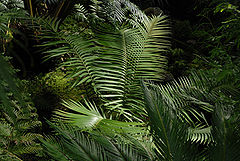- Ceratozamia
-
Ceratozamia 
Ceratozamia mexicana Scientific classification Kingdom: Plantae Division: Cycadophyta Class: Cycadopsida Order: Cycadales Family: Zamiaceae Genus: Ceratozamia
Brongn.Species 16+ extant and 1-2 fossil species; see text.
Ceratozamia is a genus of New World cycads in the family Zamiaceae. The genus contains 16-18 currently living species and one or two fossil species. Most species are endemic to mountainous areas of Mexico, while C. robusta extends into the mountains of Guatemala and Belize. The genus name comes from the Greek ceras, meaning horn, which refers to the paired, spreading horny projections on the male and female sporophylls of all species. Many species have extremely limited ranges, and almost all described species are listed as vulnerable, endangered, or critically endangered by the IUCN Red List. Illegal plant poaching has posed a major threat to Ceratozamia species.
The plants are dioecious , with a globose or cylindrical stem, rarely dichotomously branched, that may be underground or emergent. Several species produce basal shoots or suckers. The leaves are pinnately compound, straight, and spirally arranged. Leaf bases are usually deciduous but sometimes persistent. The petioles and rachis often have spines, though there may be very few to none. Leaflets are simple, entire, and articulate at the base, with parallel side veins and no distinct central vein. Male cones are cylindrical, upright, hairy, and stalked. Female cones are stalked or sessile, erect, and have short hairs. Seeds are oblong or elliptical, with a fleshy whitish outer coat.
Most species inhabit mountainous areas at 800-1000 m elevation, on sheltered slopes in moist forests. These forests range from tropical rainforests that are always wet, to pine-oak forests with alternating wet and dry seasons. There is a noticeable correlation between characteristics of species and the wetness or dryness of the habitat. Species with broad, thin leaflets live in wet habitats, and species with narrow, thick leaflets live in climates with wet and dry seasons.
No formal classification of the genus currently exists, but studies by researchers have shown that there are two major groups within the genus. The first group contains seven described species. Species in this group have small cones and thin, broad, asymmetrical leaflets that taper gradually toward the base. Species of the second group have cones that are small to large. Leaflets are narrow, thin to thick in texture, symmetrical, and do not taper toward the base. This group contains nine species.
Group 1:
- Ceratozamia euryphyllidia
- Ceratozamia hildae
- Ceratozamia latifolia
- Ceratozamia microstrobila
- Ceratozamia miqueliana
- Ceratozamia morettii
- Ceratozamia whitelockiana
Group 2:
- Ceratozamia alvarezii
- Ceratozamia kuesteriana
- Ceratozamia matudae
- Ceratozamia mexicana
- Ceratozamia mixeorum
- Ceratozamia norstogii
- Ceratozamia robusta
- Ceratozamia sabatoi
- Ceratozamia zaragozae
In addition, several species have only been very recently discovered and are not yet formally recognised. These include Ceratozamia mirandai and Ceratozamia zoquensis. There are two described fossil species, Ceratozamia hofmannii and Ceratozamia wrightii, but the former may actually be a monocotyledon. C. wrightii is the first evidence of the genus in the fossil record, with leaf fragments of the species found in Eocene deposits on Kupreanof Island in Alaska. This would support the hypothesis that there was a subtropical climate in northern areas during the Tertiary.
References
- Jones, David L. (2002). Cycads of the World: Ancient Plants in Today's Landscape. Washington, D.C.: Smithsonian Institution Press. ISBN 1-58834-043-0.
- Ceratozamia at The Cycad Pages
- Ceratozamia at the Gymnosperm Database
Categories:
Wikimedia Foundation. 2010.
